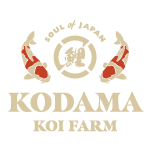Teradomari Koi Farm
Owner(s): Kiichi Hoshino
Specialty: Ginrin Kohaku
Teradomari Koi farm is a pioneer and one of the best breeder of Ginrin Kohaku.
Interview with Teradomari Koi Farm
Interview on March/April 2004
Teradomari Koi Farm
Mr. Kiichi Hoshino
by Mamoru Kodama
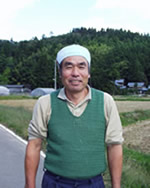
Kiichi Hoshino, Teradomari Koi Farm
Ginrin Kohaku that glitters on the beautiful pattern explains why Nishikigoi are called "living jewels." Mr. Kiichi Hoshino of Teradomari Koi Farm is the top breeder of the living jewels of Ginrin Kohaku. At this time, I would like to introduce him and his Ginrin Kohaku. Driving 20 km (12.5 miles) north from Ojiya city, the main area of koi breeding, you will find Teradomari Koi Farm.
Mr. Kiichi Hoshino, the owner of the farm, is an excellent breeder with more than 31 years of experience. His Ginrin Kohaku is especially famous. With three koi (pictured in this article), he won “Best in Variety” at the All Japan Nishikigoi Shows four times-in 1995, 1998, 1999 and 2001.
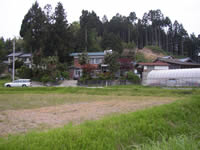
Mr. Hoshino's house
Needless to say, the title proves the highest quality of his Ginrin Kohaku. “Best in Variety”is literally the title given to the most beautiful and excellent koi in each variety at the All Japan Nishikigoi Show every year. Winning the title gives the breeder and the bloodline the recognition of a top status.
Kodama:
I heard you are related to the famous Hoshikin Koi Farm at Shiodani, Ojiya city.
Can I ask about it first?
Hoshino:
Certainly. Mr. Katsushige Hoshino is my brother-in-law. When I first decided to become a koi breeder around 1970, I started off working for Hoshikin Koi Farm. The owner at the time was Mr. Kinsaku Hoshino. I worked hard and I managed mud ponds for him. Then, I married his daughter, who is a sister of Katsushige. When I married her, I inherited his ponds in Teradomari area. This is how I started Teradomari Koi Farm.
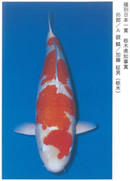
A. Best in Variety at 31st All Japan Nishikigoi Combined Show in 1999 B. Best in Variety at 27th All Japan Nishikigoi Combined Show in 1995 C. Best in Variety at 30th All Japan Nishikigoi Combined Show in 1998 D. Best in Variety at 33rd All Japan Nishikigoi Combined Show in 2001
Kodama:
I see. Then, you started to breed Ginrin Kohaku right away?
Hoshino:
No. Because of the connection with Hoshikin Koi Farm, my main breed was at first Kohaku of the Hoshikin line.
Kodama:
Then, how did Teradomari Ginrin start?
Hoshino:
Well, you know Mr. Seiji Hoshino at Kansuke Koi Farm. He is my relative and we are close. One spring, he lost all the fry. So I suddenly crossed a Hoshikin female Kohaku with a male Ginrin Kohaku that I had been raising for future Ginrin Kohaku breeding. Then, I gave 150,000 fry to him and I kept 50,000 fry.
Kodama:
You gave him most of them.
Hoshino:
Yes. It is because my main variety was still Kohaku at the time. Unfortunately, Seiji at Kansuke Koi Farm lost all the 150,000 again. But the 50,000 fry I kept just continued to grow well at my place. Best in Variety Ginrin Kohaku came out of this batch and made Teradomari Ginrin Kohaku famous.
Kodama:
How interesting. That is the beginning of the legend of Teradomari Ginrin.
Hoshino:
I would not say ‘legend,’but yes, that is the beginning.
Kodama:
But you were planning to breed Ginrin Kohaku long before. What did you have in mind when you were about to attempt to make this bloodline?
Hoshino:
In my opinion, a real and valuable koi is the one that becomes beautiful after being matured like 7, 8, even 10 years old, even though it is not beautiful at young age. Based on the idea, first of all, I started to look for the parents that can breed such koi.
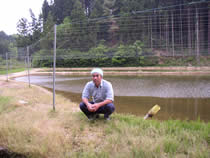
In front of fry pond
Kodama:
I see. Where did you find them?
Hoshino:
I found the koi at Suda Koi Farm about 21 years ago. At the time, Suda Koi Farm had just pulled about 400 of 2 year-old Ginrin Kohaku from his mud pond. I did not care about the beauty at that point because I wanted to breed koi that become beautiful when they grow big, not when they are young. So I chose “koi with thin but good quality color and good body conformation.”
Kodama:
So you avoided red and beautiful koi and rather looked for koi that may not be appealing, but had potential to grow big and red when it grew.
Hoshino:
Exactly. I chose such koi out of the 400.
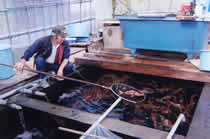
Mr. Hoshino is scooping 2 year-old 4
Kodama:
Mr. Atsushi Suda at Suda Koi Farm is a famous breeder and produces a lot of excellent koi. What did he say?
Hoshino:
He recommended to me the ones with strong Ginrin and bright red. But I did not care about them because of my policy. I rather choose the koi like I said, with weak hi and average Ginrin, but with thick layer of hi and good bone structure. I raised the koi carefully. As every year passed, the koi built such a wonderful body conformation. Hi had been enhanced. And Ginrin had also got stronger and stronger. That made me feel very confident in what I chose and I decided to start using the koi as parents. If I had wanted to breed beautiful 2-year-old koi, I would have used a parent who was beautiful at the age of 2. But I wanted to breed koi that are beautiful when more than 80 cm (32 in). I think I chose the right koi.
Kodama:
I agree with you. With this policy, you made the parents that can breed such excellent quality GinrinKohaku, even three Best in Variety champions. I found your Ginrin Kohaku absolutely beautiful and really popular. How many Ginrin Kohaku do you breed and sell?
Hoshino:
I sell my koi from 2 years old. They seem to sell well and I have many inquiries from all over Japan. This year, I bred 600 2 year-old. 400 have already been sold to Japanese koi hobbyists and 200 are planned to go to foreign countries (This interview was done at the beginning of November, 2003.)
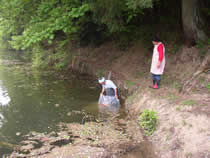
Mud ponds for raising more than 70 cm (28 in.)
Kodama:
There are not many available. Your koi are hard to get and so valuable. Not only are your koi limited, they are also beautiful. Your koi still can maintain the glitter of Ginrin even though the koi grows large and the scales expand. And the hi coloration is so strong that they have very high quality to win at koi shows.
Hoshino:
Yes. In addition, my koi’s bloodline has the body to grow more than 80 cm (32 in).
Kodama:
Absolutely. To win Best in Variety, it is very critical that the koi is more than 80 cm. No doubt this is why your koi are so popular.
Hoshino:
Thank you (smile)
Kodama:
I also noticed that your Tancho Ginrin Kohaku is especially popular. It has a nice and plump body. Ginrin glitters on the wonderful skin. It looks just as if diamonds were scattered over the pure skin. And yet, hi plate on the head is thick and big. It becomes brighter with the growth.
Hoshino:
Yes, Tancho Ginrin do quite well. As soon as they are pulled out, they are sold like they fly. There are only about 20 – 25 Tancho of 2-year-old.
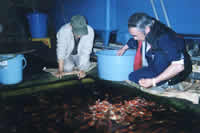
Tosai that spends winter
Kodama:
So the hobbyists who get them must be really lucky, especially the ones outside of Japan because there will not be many going out. How would you summarize the character of your Ginrin Kohaku?
Hoshino:
Again, I would say my koi are Taikibansei (late-bloomer in English) type.
Kodama:
In other words, the koi become great as they mature. They may not look beautiful when they are 2 years old.
Hoshino:
Yes. but as they pass 50 cm (20 in) they gradually show the real value of the koi. The koi has a thicker layer of hi and the color is red. Ginrin starts glittering stronger and more beautiful.
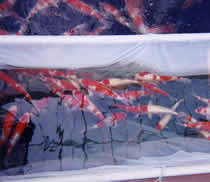
Tosai grew this big within 5 months from May to September. Tancho Ginrin is especially popular.
Kodama:
So even if your koi looks ugly, if it is young, do not give up.
Hoshino:
That is right!
Kodama:
Are you breeding something else now?
Hoshino:
I am attempting Ginrin Showa now. It is easy to make beautifully glittering Ginrin on young koi. But it is difficult to make Ginrin that stays beautiful even when it becomes 80 cm (32 in) long. Besides you must wait at least 8 years to see if the koi really becomes beautiful with strong Ginrin.
Kodama:
It is tough. Instead of getting quick satisfaction in getting beautiful 2-year-old Ginrin Showa, you breed Ginrin Showa that can win “Best in Variety”10 years later and work on making the parent that can breed such koi. Teradomari Ginrin Kohaku represents one of the best Ginrin bloodlines in Japan now. But behind it, there is a repetition of the breeding activity for more than 10 years under the one strong policy.
Thank you very much for your time today.
We have koi available to buy from Teradomari Koi Farm online if shown below the search field. If not, contact us with what you're looking for and we'll help find the right koi.
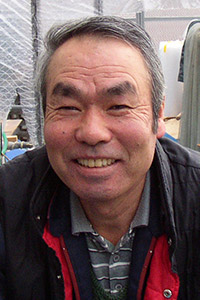
We couldn't find any products in our online store for your search in our Teradomari Koi Farm catalog,
BUT we may have inventory at the farm or in Japan, so please use the "Request a Koi" form to help us find your perfect koi fish.
Koi Auctions Ending Soon!
Place your bids now to win your choice of beautiful Japanese koi for sale at a great price! We always have a variety of fixed price koi and consistently run koi auctions ending daily; with most special auctions ending on Wednesday and Sunday each week.
-
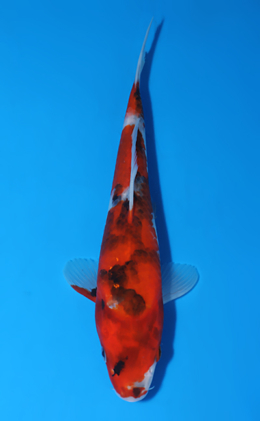
Showa – koi #x0604a019
Starting bid: $80.00Time left:Login / Register to BidEstimated Value: $300.00Breeder(s): Marudo Koi FarmSex: UnknownBorn in: 2024Size: 8.27 inch / 21 cmVariety: Showa, -
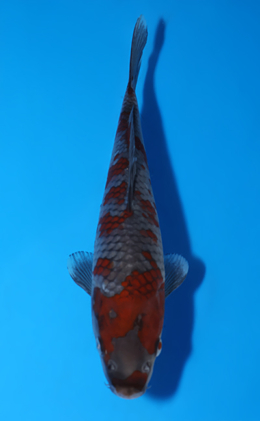
Ochiba Shigure – koi #x0604a012
Starting bid: $70.00Time left:Login / Register to BidEstimated Value: $300.00Breeder(s): Kanno Koi FarmSex: UnknownBorn in: 2024Size: 7.87 inch / 20 cm -
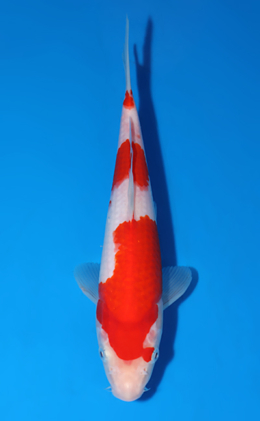
Kohaku – koi #x0604a007
Starting bid: $80.00Time left:Login / Register to BidEstimated Value: $300.00Breeder(s): Marudo Koi FarmSex: UnknownBorn in: 2024Size: 8.66 inch / 22 cmVariety: Kohaku, -
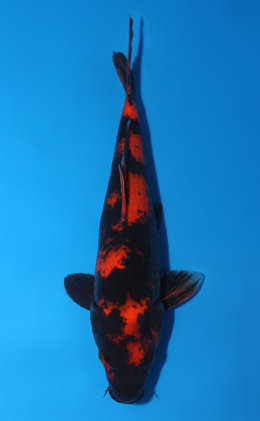
Hi Utsuri – koi #x0602a014
Starting bid: $80.00Time left:Login / Register to BidEstimated Value: $300.00Breeder(s): Maruhiro Koi FarmSex: MaleBorn in: 2024Size: 10.63 inch / 27 cm
